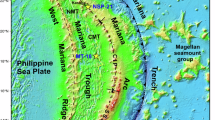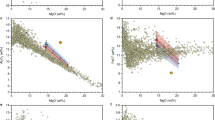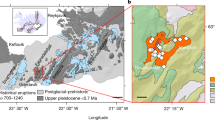Abstract
MOST petrologists recognize two fundamental types of basaltic magma—tholeiite and alkaline olivine basalt1. The ratio of alkalis to silica is consistently higher in alkaline olivine basalts than in tholeiitic (sub-alkaline2) basalts3,4. Kuno5 recognized a third type of magma, high-alumina basalt characterized by high contents of alumina and intermediate alkali, and Hamilton6 noted its apparent genetic relationship to the calc–alkaline intermediate magmas of island arcs. Joplin7 recognized a fourth type of basaltic magma characterized by high potash content, and proposed the name shoshonite8 for the magma series derived from a high-potash parent magma. The potash-rich shoshonites are as alkalic as the soda-rich alkaline olivine basalts, but the ratio of potash to soda in shoshonites is near or in excess of 1.0, whereas the same ratio is 0–5 or less in typical alkaline olivine basalts and their derivatives. Joplin noted that shoshonitic lavas seem to be especially characteristic of newly stabilized or just consolidated orogenic regions. The possibility that shoshonitic lavas might be characteristic of the late Caenozoic volcanic sequence of Fiji was called to our attention by G. A. Joplin and A. J. R. White on the basis of an analysis obtained by V. lyengar and quoted by Rickard9. The estimated volume of late Caenozoic shoshonite in Fiji is about 104 km3; therefore the origin of the magma presents a significant challenge to petrologic theory.
This is a preview of subscription content, access via your institution
Access options
Subscribe to this journal
Receive 51 print issues and online access
$199.00 per year
only $3.90 per issue
Buy this article
- Purchase on SpringerLink
- Instant access to full article PDF
Prices may be subject to local taxes which are calculated during checkout
Similar content being viewed by others
References
Tilley, C. E., Quart. J. Geol. Soc. London, 106, 37 (1950).
Chayes, F., Amer. J. Sci., 264, 128 (1966).
Kuno, H., Yamasaki, K., Iida, C., and Nagashima, K., Jap. J. Geol. Geophys., 28, 179 (1957).
MacDonald, G. A., and Katsura, T., J. Petrol., 5, 82 (1964).
Kuno, H., J. Petrol., 1, 121 (1960).
Hamilton, W., Science, 146, 634 (1964).
Joplin, G. A., Min. Mag., 34, 266 (1965).
Iddings, J. P., J. Geol., 3, 935 (1895).
Rickard, M. J., Fiji Geol. Surv. Dept. Bull., 11 (1963).
Dickinson, W. R., Tectonophysics, 4, 543 (1967).
Rodda, P., NZ J. Geol. Geophys., 10, 1260 (1967).
Higgs, R., and Coulson, F. I., Fiji Geol. Surv. Econ. Inv., 4 (in the press).
Dickinson, W. R., Amer. J. Sci. (in the press).
Ibbotson, P., Fiji Geol. Surv. Mem., 3 (in the press).
Tilley, C. E., and Muir, I. D., Geol. Foren. Stockholm Forh., 85, 434 (1964).
Author information
Authors and Affiliations
Rights and permissions
About this article
Cite this article
DICKINSON, W., RICKARD, M., COULSON, F. et al. Late Caenozoic Shoshonitic Lavas in North-western Viti Levu, Fiji. Nature 219, 148 (1968). https://doi.org/10.1038/219148a0
Received:
Revised:
Published:
Issue date:
DOI: https://doi.org/10.1038/219148a0
This article is cited by
-
Les caract�res magmatiques du volcanisme plio-quaternaire des Andes dans le Sud du P�rou
Contributions to Mineralogy and Petrology (1973)
-
A propos des ?and�sites? des A�ores
Contributions to Mineralogy and Petrology (1972)
-
Lead and strontium isotopes in rocks of the Absaroka volcanic field, Wyoming
Contributions to Mineralogy and Petrology (1970)
-
Geochemistry of Viti Levu, Fiji, and its evolution as an island arc
Contributions to Mineralogy and Petrology (1970)



